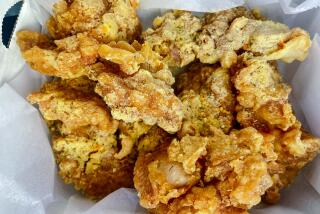Competition Gains on Colonel Sanders in Japan : Food: Other chains and supermarkets are selling fried chicken. KFC stock has dropped 27% this year.
- Share via
TOKYO — Kentucky Fried Chicken Corp. opened its first Japanese restaurant in 1970 in the suburbs of Nagoya, a dull industrial city southwest of Tokyo.
It bombed. Some days it took in only a few hundred dollars.
Most Japanese still get around by train and subway. On the way home they like to pick up dinner in the crowded shopping streets around subway stations that look pretty much the same from Nagoya to Nagasaki: a pub or two, a vegetable stand, a noodle shop and a fast-food joint.
So KFC went into the cities. Now it’s gone a little too far. It packed some of its 1,000 restaurants so close together during the booming 1980s that these days it’s having to close them. One restaurant was just shuttered in Tokyo’s seamy Kabukicho red-light district to give three others in the same neighborhood a chance to breathe.
And that’s not KFC’s only problem. Several Japanese fast-food chains are now selling fried chicken.
The Japanese, it seems, are getting tired of the Colonel’s wares.
“It’s very hard,” says Senior Managing Director Mitsuru Uno, “to sell chicken these days.”
And no wonder. Japan’s frail economy means consumers are pinching their pennies. Prices are falling, squeezing profits for makers and sellers of everything from tires to transistors, including fast-food chains. The population isn’t growing very fast, which means there are fewer new consumers.
Then there are the two Japanese fast-food chains that started as knockoffs of McDonald’s: Mos Food Service and First Kitchen. Both now sell their own fried chicken, as do supermarkets and convenience stores.
When that first KFC opened in Nagoya in 1970, some of the store’s neighbors thought that it was a barber shop with its bright red-and-white exterior. KFC has come a long way since. Sales last year were about $778 million.
For all the competition, the company still sells about 80% of the fried chicken sold by fast-food restaurants in Japan.
Its market dominance probably won’t last, though. Sales for each restaurant have been dropping since the late 1980s.
KFC has closed 50 unprofitable outlets in the last four years and will close as many as 50 more soon.
Investors aren’t impressed. The stock has dropped 27% so far this year, recently trading at about $14 a share. All the other companies in the first section of the Tokyo stock market have fallen only half as much. (Kentucky Fried Chicken Japan is a publicly held joint venture between KFC and Mitsubishi Corp., Japan’s largest trading company.)
And the stock’s not likely to liven up soon, says Toshiko Binder, who follows the food industry for brokerage S.G. Warburg.
KFC in Japan doesn’t have to worry about the backlash against grease and fat that forced the company to start broiling some of its chicken in the United States. The Japanese may have one of the healthiest diets in the world, full of fish and rice, but they still love fried food. They eat lots of tempura--vegetables fried in egg batter--and fried dumplings.
Fat’s not the problem--price is. KFC is expensive, even for Japan, where a roast beef on rye can set you back $20 or so.
Though McDonald’s has cut prices on its burgers here, KFC refuses to sell cheap chicken, saying that doing so would hurt quality.
For years, a small piece of KFC chicken has cost about $2.25. A single meal of two pieces of chicken, a large Coke, salad, biscuit and small order of french fries can easily top $10.
“I come here very rarely because the menu is very limited,” college student Sakiko Yamakawa says at a KFC restaurant in Saitama prefecture near Tokyo. “It’s also very expensive.”
KFC refuses to import chickens, even though the strong yen would make doing so inexpensive. The problem: Imported chickens are frozen.
Then, too, Japanese chickens are fed fish and seaweed, which gives them a slightly different flavor from chicken fed grain.
“The Japanese are sensitive to subtle flavors,” explains KFC spokeswoman Sumeo Yokokawa.
KFC also caters to Japanese palates by selling rice balls and salmon sandwiches.
Otherwise, it offers the same menu and fries its chickens the same way that it does in the States, although it’s invented frying equipment a third the size of what it uses at home for Japan’s tiny restaurants. Many fast-food restaurants here are so squeezed by land prices that they are shoehorned onto several floors and customers are herded from the counter to cramped dining rooms up narrow stairs.
Oh, and there’s one more thing: Some of the 600 franchised restaurants here will also sell you a Coke with your chicken. That’s a no-no in company-owned restaurants. KFC--like the Pizza Hut and Taco Bell chains--is owned by PepsiCo Inc.
Some of the franchisees, it seems, are Coke bottlers.
More to Read
Inside the business of entertainment
The Wide Shot brings you news, analysis and insights on everything from streaming wars to production — and what it all means for the future.
You may occasionally receive promotional content from the Los Angeles Times.










